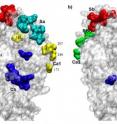Study reveals H1N1 unexpected weakness
The H1N1 influenza virus has been keeping a secret that may be the key to defeating it and other flu viruses as well. Researchers at Rice University and Baylor College of Medicine (BCM) have found what they believe is a weakness in H1N1's method for evading detection by the immune system.
Comparing its genetic sequences going all the way back to the virus's first known appearance in the deadly "Spanish flu" outbreak of 1918, they discovered a previously unrealized role of receptor-binding residues in host evasion, which effectively becomes a bottleneck that keeps the virus in check.
Rice's Jianpeng Ma and graduate student Jun Shen and BCM's Qinghua Wang compared the sequences of more than 300 strains of H1N1 to track its evolution; they reported their results in a recent online edition of the scientific journal PLoS ONE.
The researchers were looking in particular at hemagglutinin (HA), the protein "hook" that allows the virus to attach itself to and infect host cells. It's long been known that five regions of H1N1's HA serve as antigenic sites, the protein fragments that trigger the body's immune system. These antigenic sites, first mapped in 1981, shuffle their amino-acid sequences in the endless cat-and-mouse game that viruses play to survive.
The researchers discovered several key residues involved in both antigenic sites and the receptor-binding site, the part of the protein that attaches to a cell and allows the virus to invade.
The common belief has been that the receptor binding could not change. "The site is known, but no one thought it was involved in the immune system. In order to recognize the receptor, that particular region has to be robust," Ma said. "But it turns out this region is not only variable, but also interacts with the immune system."
For a virus to evade antibodies, all five antigenic sites would have to disguise themselves by mutating. The new finding led the researchers to believe the receptor-binding residues would also have to mutate, but not so much that the binding no longer works. "If the binding is abolished, the virus dies," said Ma, a Rice professor in bioengineering with a joint appointment at BCM.
Such dual-function residues are a likely bottleneck for the virus, he said, because they're under the tightest restrictions. Thus, they could be easier to track over time and may chart a path to predict future mutations that will aid in vaccine design.
"It becomes a weak link and provides us with a window into the virus that we can monitor," Ma said. "The virus's bottleneck is our opportunity."
Wang, an assistant professor of biochemistry and molecular biology at BCM who has long studied the structure and function of HA, has been involved in the project since it began and is now working to verify the results in vitro. She hopes confirming the computations will lead to more efficiency in creating vaccines not only for H1N1 but also for other strains of the flu.
"An underlying implication is that this may not be restricted to H1N1," Wang said. "It may apply to other influenza viruses as well. If studying viral evolution can help predict what will cause a severe problem in humans, you can actually pre-stock vaccines, which will save time."
Source: Rice University
Articles on the same topic
- New York autopsies show 2009 H1N1 influenza virus damages entire airwayMon, 7 Dec 2009, 20:45:50 UTC
Other sources
- Study reveals H1N1 unexpected weaknessfrom Science BlogThu, 10 Dec 2009, 18:21:18 UTC
- Study reveals H1N1 unexpected weaknessfrom PhysorgThu, 10 Dec 2009, 17:28:53 UTC
- Unexpected weakness in H1N1's method for evading detection by the immune systemfrom Science DailyThu, 10 Dec 2009, 17:28:19 UTC
- New York autopsies show 2009 H1N1 influenza virus damages entire airwayfrom Science DailyTue, 8 Dec 2009, 6:22:03 UTC
- New York autopsies show 2009 H1N1 influenza virus damages entire airwayfrom PhysorgMon, 7 Dec 2009, 21:49:16 UTC
- New York autopsies show 2009 H1N1 influenza virus damages entire airwayfrom Science BlogMon, 7 Dec 2009, 20:42:30 UTC
